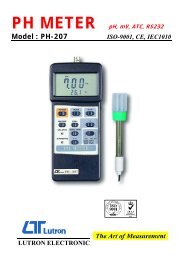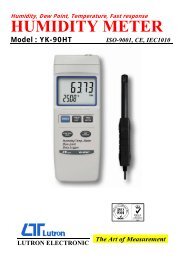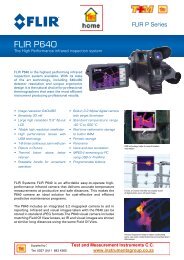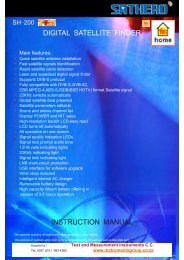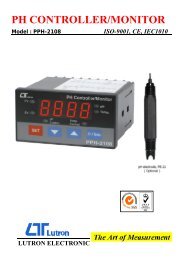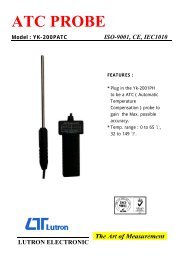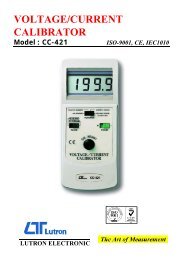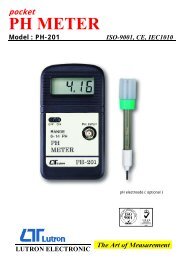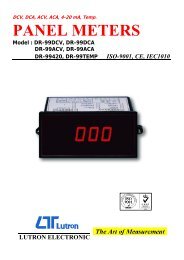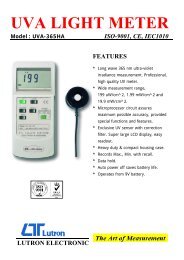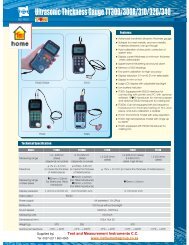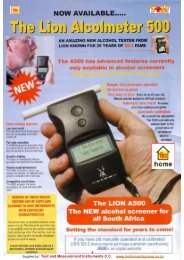HIGH VOLTAGE PROBE - Test and Measurement Instruments CC
HIGH VOLTAGE PROBE - Test and Measurement Instruments CC
HIGH VOLTAGE PROBE - Test and Measurement Instruments CC
You also want an ePaper? Increase the reach of your titles
YUMPU automatically turns print PDFs into web optimized ePapers that Google loves.
DCV - 0 to 40 KV, ACV - 0 to 28 KV rms<br />
<strong>HIGH</strong> <strong>VOLTAGE</strong> <strong>PROBE</strong><br />
Model : HV-40 ISO-9001, CE, IEC1010<br />
LUTRON ELECTRONIC
<strong>HIGH</strong> <strong>VOLTAGE</strong> <strong>PROBE</strong><br />
Model : HV-40<br />
SPECIFICATIONS<br />
Attenuate Ratio 1 : 1000.<br />
Input Impedance Approx. 1000 M ohm.<br />
Output<br />
Around 1.1 M ohm. The input impedance of external voltmeter<br />
Impedance<br />
should be 10 mega ohm.<br />
Safety<br />
Meet CAT II 40000 V<br />
Max. Working DCV DC 40 KV<br />
Voltage ACV Peak AC 40 KV or 28 KV rms<br />
( depend which values is larger ).<br />
Accuracy DCV 1 KV to 20 KV - ± 1 %.<br />
20 KV to 40 KV - ± 1.5 %.<br />
ACV 1 to 28 KV rms, 50/60 Hz - ± 5 %.<br />
Temp Coefficient Less than 200 ppm/ 蚓 .<br />
Operating Temperature 0 to 50 ℃ ( 32 to 122 ℉ ).<br />
Operating Humidity Less than 80% RH.<br />
Cable Length<br />
1 meter.<br />
OPERATION<br />
Connect the plugs to the volts ( Hi ) & com ( Lo ) input terminals of your voltmeter ( or<br />
Multimeter ). Select the desired range of voltmeter ( Attention : Do not use auto ranging ).<br />
Whenever possible, turn the high voltage source off before making any connections. Connect<br />
the HV probe common lead ( alligator clip ) to a good earth ground or reliable chassis ground.<br />
SAFETY PRECAUTION & WARNING !!!<br />
* This high voltage probe must be used by the person who are trained only. Do not work alone<br />
when working with high voltage circuits & environment.<br />
* For your own safety, inspect the probes for cracks & frayed or broken leads before each use.<br />
If any defects are noted, do not use the probes.<br />
* H<strong>and</strong>s, shoes, floor & work bench must be dry. Avoid making measurements under humid,<br />
damp or other environmental conditions that might affect the safety of measurement<br />
situation.<br />
* The ground connection must always be made before the probe tip comes into contact with<br />
the high voltage & must not be removed until after the probe tip has been removed from<br />
high voltage source.<br />
* Do not attempt to take measurement from sources where the chassis or return lead is not<br />
ground.<br />
* If possible, always turn the high voltage source off before connecting or disconnecting the<br />
probe.<br />
* Before turning the high voltage on, make sure that no part of your body is in contact with<br />
the device under test.<br />
* The probe body should be kept clean & free of any conductive contamination. Clean only<br />
the exterior probe body & cables. Use a soft cotton cloth lightly moistened with a mild<br />
solution of detergent & water. Do not allow any portion of the probe to be submerged at<br />
any time.<br />
* Appearance <strong>and</strong> specifications listed in this brochure are subject to change without notice. 0412-HV40



